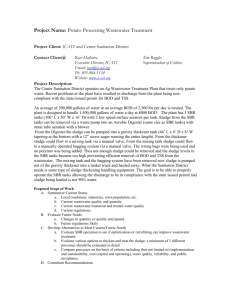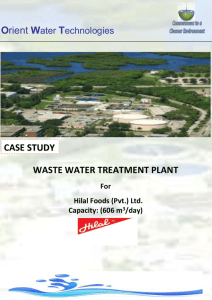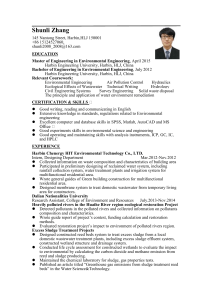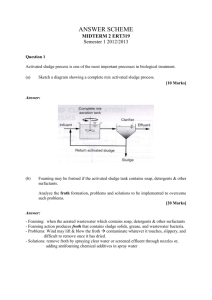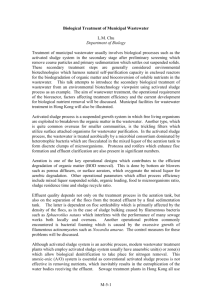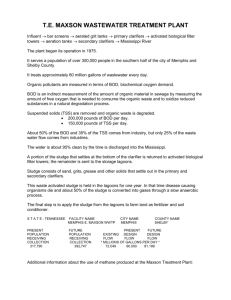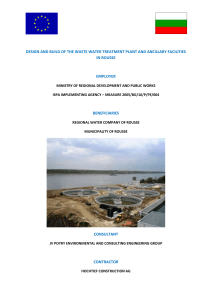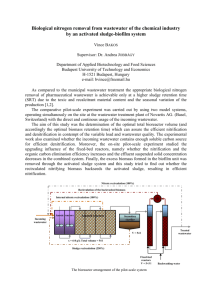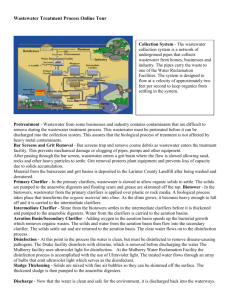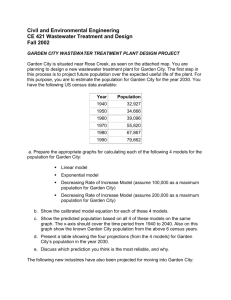rbc process description
advertisement
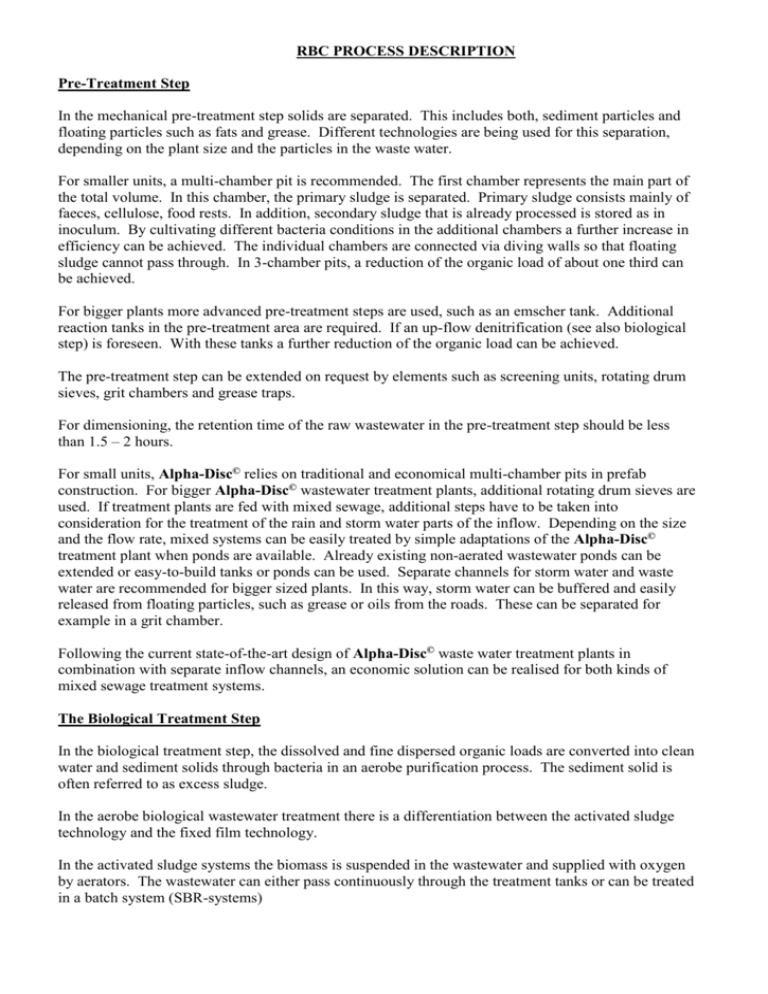
RBC PROCESS DESCRIPTION Pre-Treatment Step In the mechanical pre-treatment step solids are separated. This includes both, sediment particles and floating particles such as fats and grease. Different technologies are being used for this separation, depending on the plant size and the particles in the waste water. For smaller units, a multi-chamber pit is recommended. The first chamber represents the main part of the total volume. In this chamber, the primary sludge is separated. Primary sludge consists mainly of faeces, cellulose, food rests. In addition, secondary sludge that is already processed is stored as in inoculum. By cultivating different bacteria conditions in the additional chambers a further increase in efficiency can be achieved. The individual chambers are connected via diving walls so that floating sludge cannot pass through. In 3-chamber pits, a reduction of the organic load of about one third can be achieved. For bigger plants more advanced pre-treatment steps are used, such as an emscher tank. Additional reaction tanks in the pre-treatment area are required. If an up-flow denitrification (see also biological step) is foreseen. With these tanks a further reduction of the organic load can be achieved. The pre-treatment step can be extended on request by elements such as screening units, rotating drum sieves, grit chambers and grease traps. For dimensioning, the retention time of the raw wastewater in the pre-treatment step should be less than 1.5 – 2 hours. For small units, Alpha-Disc© relies on traditional and economical multi-chamber pits in prefab construction. For bigger Alpha-Disc© wastewater treatment plants, additional rotating drum sieves are used. If treatment plants are fed with mixed sewage, additional steps have to be taken into consideration for the treatment of the rain and storm water parts of the inflow. Depending on the size and the flow rate, mixed systems can be easily treated by simple adaptations of the Alpha-Disc© treatment plant when ponds are available. Already existing non-aerated wastewater ponds can be extended or easy-to-build tanks or ponds can be used. Separate channels for storm water and waste water are recommended for bigger sized plants. In this way, storm water can be buffered and easily released from floating particles, such as grease or oils from the roads. These can be separated for example in a grit chamber. Following the current state-of-the-art design of Alpha-Disc© waste water treatment plants in combination with separate inflow channels, an economic solution can be realised for both kinds of mixed sewage treatment systems. The Biological Treatment Step In the biological treatment step, the dissolved and fine dispersed organic loads are converted into clean water and sediment solids through bacteria in an aerobe purification process. The sediment solid is often referred to as excess sludge. In the aerobe biological wastewater treatment there is a differentiation between the activated sludge technology and the fixed film technology. In the activated sludge systems the biomass is suspended in the wastewater and supplied with oxygen by aerators. The wastewater can either pass continuously through the treatment tanks or can be treated in a batch system (SBR-systems) In fixed film systems, the biomass grows on supporting plates. The bacteria consume the required oxygen from the surrounding atmosphere. In trickling filters, the growing surface consists of an open grating structure, which allows the biofilm to be surrounded at the same time by wastewater and atmosphere. In immersion disc plants, the biofilm situated on the growing surface is intermittently exposed to the atmosphere and the wastewater to be treated. For special applications, combinations of the above mentioned technologies are used. The aerobe biological treatment process leads first of all to the reduction of organic carbon compounds, described by the values of BOD5 and COD. Furthermore, the harmful and volatile ammonia nitrogen is converted into immobile nitrate nitrogen. This process is called nitrification. For both processes, treatment efficiencies of up to 99% can be reached. If the treated wastewater is recirculated into an upstream reaction tank, denitrification can also be achieved. In this process, the carbon compounds of the reaction tanks detract the oxygen fixed in the nitrate so that the nitrogen can escape in elemental form. The advantage of the aerobe biological technologies is the almost odourless process of the wastewater treatment. For high loaded industrial wastewaters, it is best to then use biological anaerobe technologies using a digestive processes. Alpha-Disc© uses the rotating immersion disc technology for the biological wastewater treatment. This technology represents a combination of trickling filter and biological contactors. The rotating immersion discs provide the most energetically efficient technological process, as only the rotor with the biomass turns so as to keep mechanical abrasion minimal. For the dimensioning of the biological rotating immersion disc step, Alpha-Disc© follows the ATV-guideline A 281. For other climate zones, this guideline is appropriately modified thanks to the Alpha-Disc© experience of more than 20 years. Plants in which the required oxygen is brought into the wastewater via compressed air or surface aerators have an energy demand of 50% more that plants based on biodisc technology. The high sludge age of the biomass achieved through the fixed film process used by Alpha-Disc© proves that the excess sludge production is up to 50% less . The Final Clarification Step In the mechanical clarification step, the particulate matter caused by the biological process is separated out as excess sludge via sedimentation. For this process two technical conditions must be fulfilled: the sludge has to be heavier than the surrounding water and second, turbulences in the clarifier tank must be avoided. The excess sludge sinks to the tank bottom due to its higher density and is withdrawn from the tank bottom in certain intervals for storage in the sludge tank. For this withdrawal it is important that the sludge remains not too long in the clarifier tank, as otherwise it will float due to anaerobe digesting and gas formation. This floating sludge can be removed under normal conditions, although rather difficultly. In the field of final clarification, Alpha-Disc© has worked with the lamella separators for decades. These separators are specially adapted to the technology of the rotating immersion discs. The higher density and resulting higher sinking velocity of the fixed film excess sludge are helpful in this process. The construction concept of very short settling distances leads to an extremely compact construction. Alpha-Disc© lamella separators require only about 20% of the surface of conventional clarifiers. This allows the settled sludge to be thickened up to 1,5%-vol of dry matter. Alpha-Disc© lamella separators are also used as intermediate clarifiers and in a wide range of technical sedimentation processes for industrial applications.

